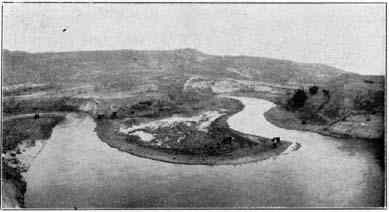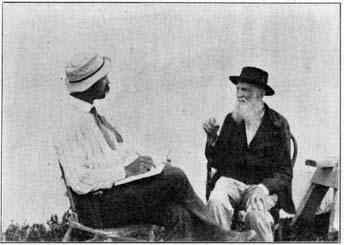|
J. T.
MCCLUSKEY |
|
SEMI-CENTENNIAL HISTORY OF NEBRASKA CHAPTER I Where does the history of Nebraska begin? This first, fundamental query lies across the opening of my story as I have seen a cottonwood log lie athwart the doorway of a settler's cabin. Does it begin with the written record of the first white explorer? With the first vague accounts carried by Indians to distant white men's trading posts? Farther back among the unwritten Indian traditions told for ages about campfires, transmitted and transmuted in memory down the generations? Does it begin back of all tradition--with the bones in the burial mounds along the Missouri Valley, with the chipped 
Scene on Dismal River flints and ashes of fires long ago buried deep beneath Nebraska soil? Or still beyond,--in quartzite boulders dropped by glacial ice on the hilltops, in the beds of subsoil clay and sand beneath, in the shales and sandstones below them, in the blocks of solid limestone deeper yet? |
At the start one great difficulty is met; the leaves will not turn. They lie piled one upon the other in nearly horizontal sheets, some of them deeply buried from sight. There are three principal ways of getting at them to read their contents. The first is to go to the mountains beyond where the leaves are bent up in great folds, crumpled and exposed. The second is to find where the streams of water have cut down through them in Nebraska exposing the edges. The third is to dig into them. All three methods have been employed and the results compared. From them it is possible now to write much of the history of Nebraska long before there were any human beings here or even any dry land for them to stand on. 
A Nebraska Brachiopod. Coal Measure Sea Shell. the Platte, the Blue, the Missouri and other streams which have cut valleys in the limestone hills the quarryman works in the cemetery of the past, blasting and carving out the skeletons of former inhabitants to serve the purposes of present ones. This was the great coal-forming or Carboniferous Age when the deep beds of coal in Iowa, Kansas and Missouri were being created. Nebraska was too far out on the edge of coal-making conditions to produce any deep beds, but the story of her part in that period of millions of years is written deeply in her rocks. A layer of black, soft shale filled with vegetable remains tells the story of a period of swamp; another layer of marly limestone intermingled with fossils tells the story of a shallow sea swarming with animal life; a thick stratum of solid stone with few fossils tells the tale of a deep sea. Through millions of years these alternations of depression and elevation, of swamp and shoal and sea, went on writing roughly their record in the rocks. These limestone rocks themselves with their interlying layers of shales and softer material are from six hundred to one thousand two hundred feet in thickness. They are the oldest Nebraska history. Thus far only the |
 |
 |
 |
 |
|
@ 2002 for the NEGenWeb Project by Pam Rietsch, Ted & Carole Miller |
|||
